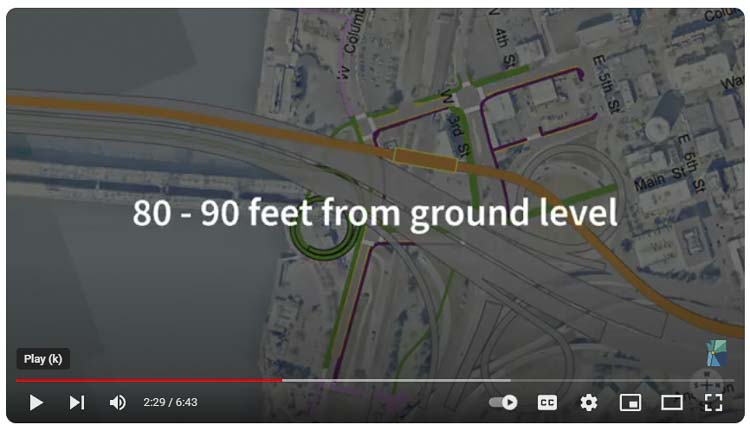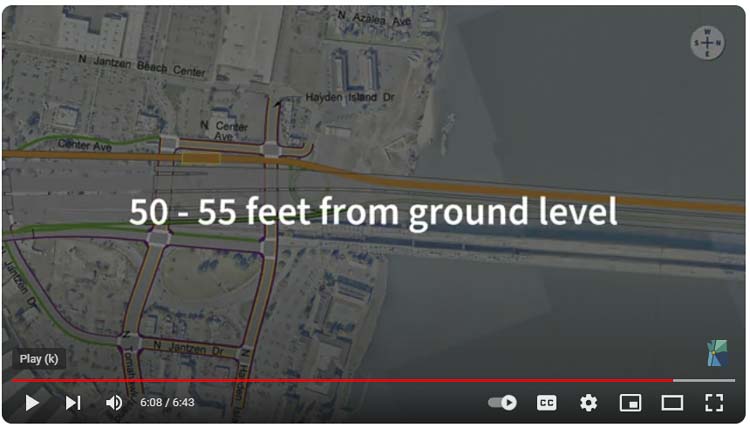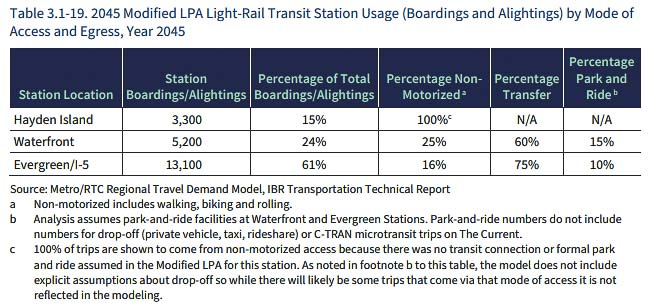
Over half the replacement bridge will be dedicated to transit and active transportation. But will people use it instead of their cars?
John Ley
for Clark County Today
One of the hundreds of issues area residents will want to offer “comment” on regarding the proposed Interstate Bridge replacement project is the active transportation facilities. On Friday, the Interstate Bridge Replacement Program (IBR) opened a 60-day public comment period as it released the roughly 10,000-page Draft Supplemental Environmental Impact Statement (DSEIS). The documents are now published, and the 60-day public comment period is open Sept. 20 through Nov. 18, 2024.
The current proposed project will spend at least $7.5 billion, including $2 billion for transit and active transportation facilities on the bridge. These facilities include transit stops at both the Vancouver waterfront and on Hayden Island. The IBR proposal has allocated 54 percent of the surface of the bridge for transit, bikes, and pedestrians, and only 46 percent for vehicles and freight haulers.
The program revealed earlier in the process that there are 370 active transportation trips a day, compared to over 165,000 general purpose vehicle trips. The DSEIS states “an estimated 410 bicyclists and pedestrians, on average, make trips across the bridge daily.”
One issue for Vancouver citizens has been the waterfront transit stop. The MAX light rail station and bike/pedestrian facilities would be above an active BNSF rail line. The program had previously told the 16 members of the Bi-State Legislative Committee that it could be up to 90 feet above the ground, which brought a lot of pushback.
An additional consideration has been the need for the project to seize the Hurley building, which is just five years old. This is the site for the proposed waterfront transit station.

As part of their communication regarding the DSEIS, the IBR has revealed that the Vancouver waterfront transit station and active transportation facility will be 80 to 90 feet above the ground. A video seems to indicate there will be a double spiral ramp needed to get bikes and pedestrians down to ground level. They also reveal that the Hayden Island facility will be 50 to 55 feet above the ground.
“We are doing some unique things that are different than you would see on a mega project anywhere else,” said Greg Johnson, IBR administrator earlier this summer. “No. 1, you don’t see a lot of bike, walk and roll facilities on interstate highways. And this one, we are making it an attractive part of what we are doing to try and get folks out of those single-occupancy vehicle trips.”
In June, Sen. Lynda Wilson told Johnson they should be focusing on the needs of cars and freight haulers. “I have a concern that we’re paying more attention to multimodal transportation,” she said.
There appears to be no breakdown of cost data for the various components of the transit piece of the IBR. What are the details of the Vancouver waterfront transit station? What are the costs of each of those proposed details? There is a possible Park ‘n Ride facility at that location. How many vehicles will use it for transit, and what is the cost?
If citizens are to provide input on the tens of thousands of details contained within the DSEIS, shouldn’t they know the costs in addition to why any particular component is “needed” and included in the project?
A logical question is how many transit riders does the IBR expect to use the Vancouver waterfront transit station? The IBR predicts 3,300 boardings or about 1,650 people a day. How many bikers and pedestrians will use a station that high above the ground?
With the Evergreen transit center (end of the line) just about 2,500 feet away to the north, why wouldn’t those active transportation people stay on the light rail until they reach ground level? This would be especially true during wind and rain experienced during the late fall, winter, and spring weather events.
Similar questions are appropriate for Hayden Island. How many people is the IBR program expecting to use the facility on the island?

The DSEIS has information on transit ridership in Chapter 3. But much of it is from 2019 rather than more current data. Earlier this year, the Regional Transportation Council (RTC) Board was briefed that there is a “new normal” both locally and nationally, with reduced transit ridership, more people working from home, and people using their privately owned vehicles.
There are even greater questions regarding the “need” for any high capacity transit on the project. Presently, there is so little demand for cross river transit, that only C-TRAN offers bus service. The decline in ridership due to pandemic lockdowns caused the bus company to reduce their “Express” bus service from seven separate lines down to just three bus lines. And that is for both the I-5 and I-205 corridors.
In 2023, C-TRAN reported just 525 boarding a day on their I–5 express buses. These are routes 105 and 105X. They reported 295 boardings on their express route 164 which uses I-205.
The 105X route is the fastest, avoiding a stop in downtown Vancouver. They currently offer five buses in the morning and five in the evening. The non-express 105 route service includes a stop in downtown and runs about every 45 minutes, depending on the time of day. In the morning it can be every 15 or 20 minutes, and hourly during the rest of the day.
In the past, when TriMet added MAX light rail service, it was simply replacing existing bus service with more expensive light rail service. Will C-TRAN further cut back bus service over the river?

The DSEIS states the following about the Waterfront Station.
As described in Chapter 2, there are three site options for a new park and ride facility near the proposed Waterfront Station. Two of these sites (Sites 2 and 3) would require the acquisition of additional property beyond that needed for the highway and transit facilities. Site 2 would require full acquisition of one commercial parcel and no displacements. Site 3 would require full acquisition of four commercial parcels and displacement of one business. Site 1 would not require any acquisitions or displacements. Property impacts associated with the Waterfront Station park-and-ride options are shown in Table 3.3-4 and are in addition to the impacts identified in Table 3.3-3.
Additional perspective is that C-TRAN officials told the Federal Transit Administration (FTA) they expected 5,000 to 6,000 daily boardings on their Vine Bus Rapid Transit service on opening day. They predicted growth to 8,000 to 9,000 boardings. In 2023, ridership was down to 3,232 boardings on Fourth Plain in 2023. These ridership projections seem overly “optimistic” in the extreme.
Randall O’Toole has been examining transit for decades and is known as the “Anti Planner.” He talks about “strategic misrepresentation” as a form of lying on light rail and these mega projects. He notes they over project transit ridership and under estimate costs in a recent column entitled, “Lie Rail Supporters Keep On Lying.’’
Citizens can make input and public comments here (item 4 on the page).
Also read:
- Expect delays on northbound I-5 near Ridgefield through May 9Northbound I-5 travelers near Ridgefield should expect delays through May 9 as crews work on improvements at the Exit 14 off-ramp to support future development.
- 6-cent gas tax hike central to new transportation deal in WA LegislatureA proposed 6-cent gas tax hike is central to a transportation funding deal under negotiation in the Washington Legislature, aimed at raising $3.2 billion over six years.
- Letter: C-TRAN Board improper meeting conductCamas resident Rick Vermeers criticizes the C-TRAN Board for misusing parliamentary procedure during a controversial vote on light rail.
- Opinion: TriMet’s ‘fiscal cliff’ a caution for Clark County taxpayersRep. John Ley warns that Portland’s financially troubled TriMet transit system could pose major risks to Clark County taxpayers as the I-5 Bridge replacement moves forward.
- Travel Advisory: Expect daytime delays on northbound I-5 near Woodland for guardrail repairs, April 18WSDOT will close the left lane of northbound I-5 near Woodland on Friday, April 18, to repair guardrail and improve driver safety.









